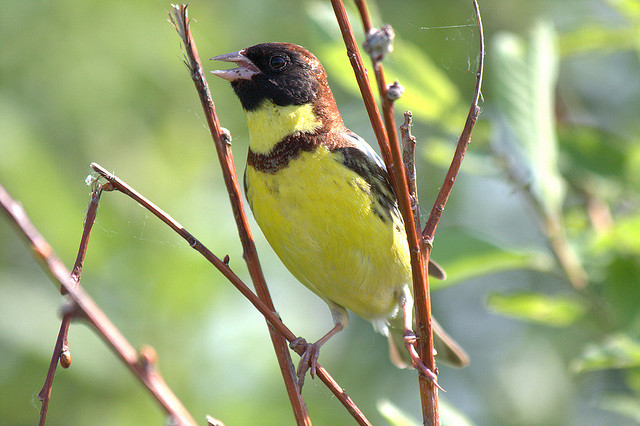Nepal

Conservation biologists have stressed the need to protect the threatened Bagale Bagedi, the yellow-breasted bunting (Emberiza aureola). The bird has been reclassified as critically endangered on the red list of threatened species by the International Union for Conservation of Nature (IUCN).
Ornithologists highlighted those facts at a seminar on the conservation of Bagale Bagedi organised by the Pokhara Bird Society on Sunday.
Anisha Rana, a researcher on Bagale Bagedi, said that this species of buntings migrate to Nepal from the Siberian region to escape the harsh winter cold. However, its population is nominal at the global and national levels.
The yellow-breasted buntings usually arrive in Nepal from Siberia around mid-November and stay in Nepal for about six months before returning to Siberia, she noted. "These birds inhabit the wetlands near the lakes in Pokhara."
A total of 230 species of this bird are found in Phewa Lake, 12 in Gunde Lake and 13 in Khaste Lake, Rana said, citing a survey report. "However, this bird is not seen in the six remaining lakes in Pokhara."
Another researcher Amrit Poudel gave more insight into the bird. "This bird's habitat is in the wetland, farmland and grassland," he said. "Similar to a sparrow in size, the bunting is an attractive bird. It weighs 22 grams on average, and the size varies between 14 and 16 centimetres. Its average lifespan is seven years."
It migrates to Nepal from Russia, Mongolia and China during the winter. The yellow-breasted bunting population has declined sharply over the past decade due to excessive trappings, according to the IUCN. The bird is highly endangered globally, as people often hunt it for its meat.
A working paper on the yellow-breasted buntings, distributed at the seminar, says out of 11,225 species worldwide, 886 species of birds are recorded in Nepal.
The protected bird species of Nepal are the Black Stork (Ciconia nigra), the White Stork (Ciconia ciconia), the Sarus Crane (Grus antigone), the Cheer Pheasant (Catreus wallichii), the Himalayan Monal/Impeyan Pheasant (Lophophorus impejanus), the Satyr Tragopan (Tragopan satyra), the Bengal Florican (Houbaropsis bengalensis) and the Lesser Florican (Sypheotides indicus).
According to ornithologists, sixty-two species of birds arrive in Nepal during the summer, while 152 species of birds migrate to Nepal during winter to escape the cold. Similarly, 50 species of birds arriving in Nepal are migratory, while 79 are wanderers. - RSS






